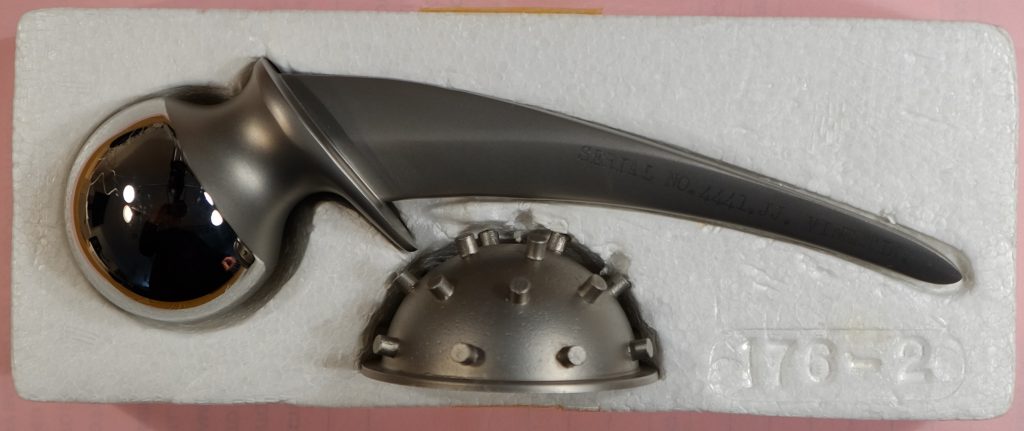The idea of replacing damaged joints with artificial prostheses is thought of as a 20th century development but was first tried in Berlin in 1890 by a German surgeon called Themistocles Gluck (1853-1942). Tuberculosis had damaged the knee of a 17-year-old girl and Gluck replaced the joint with a hinged ivory prosthesis. He had already experimented with transplantation of ivory and other substances in animals and was convinced that humans could tolerate foreign material. Shortly after operating on the girl’s knee he performed a total wrist replacement using an ivory prosthesis. Although Gluck’s joint replacements were initially extremely successful, they ultimately failed because of chronic infection. His operations were all done on joints already infected, mostly by tuberculosis.
Today, artificial joint replacements are routinely performed to replace damaged or diseased joints. Hip fractures which used to require weeks in hospital with prolonged immobilisation now require a mere 3 days from operation to discharge provided there are no complications. Unlike Gluck’s era, today’s surgeons have the benefit of air-conditioned operating theatres and antibiotics which largely overcome the risk of bacterial infection and modern anaesthetic techniques which allow patients to rapidly recover from their operations.
The first authenticated ivory joint replacement in the UK was done with a mushroom shaped femoral head prosthesis. The operation was performed by a Bristol surgeon, Ernest Hey Groves (1872-1944), in 1923. It quickly wore away but set in motion the search for other suitable materials. Modern prosthetic hip joints are based on the work of Sir John Charnley (1911-1982) using a high molecular weight polyethylene liner in the acetabular cup part of the prothesis. This was found to be extremely hard wearing and safe to use inside the body. Charnley developed his ideas for total hip replacement in the 1960s at Wrightington Hospital in Lancashire where he set up a hip surgery centre.
Over the years, other surgeons have produced their own versions. Jean and Robert Judet were both internationally acclaimed professors of orthopaedic surgery in Paris during the 20th century. The brothers were pioneers hip prostheses and in 1947 performed the first arthroplasty in the world to replace a fractured neck of femur. Unfortunately, their lives were later blighted by a tax fraud scandal and in 1976 they were given a one-year suspended prison sentence. They were stripped of their Legion d’honneur medals, awarded to them for acts of war time resistance, and lost their standing in the Paris medical faculty. In 1981 they were both cleared of the charges and their rights restored. Their “Judet acrylic hip prosthesis” was invented in 1949. Although acrylic femoral heads were prone to disintegration, a few patients had them for over 50 years before they failed.

Kenneth McKee (1906-1991) was an orthopaedic surgeon working in Norwich who developed his own version of prosthetic hip joints in the 1940s and 1950s. He was aided by his fellow consultant John Watson-Farrar (1926-1999) who had first worked as McKee’s registrar at the Norfolk and Norwich Hospital. The McKee-Farrar hip joint prosthesis, launched in 1961, did not have any lining in the cup; metal articulates on metal. Prostheses like these are very hard wearing but recently concern has arisen because of the release of small quantities of metal ions into the surrounding tissues. This can sometimes lead to problems so patients with metal on metal joint surfaces are regularly monitored. Metal articulating with polyethylene does not cause this problem.

Below is a trailer for a video on the process of total Hip Replacement Surgery conducted by Mr Matthew Burwell at Circle Hospital Bath in Peasedown.
Article By Dr Roger Rolls